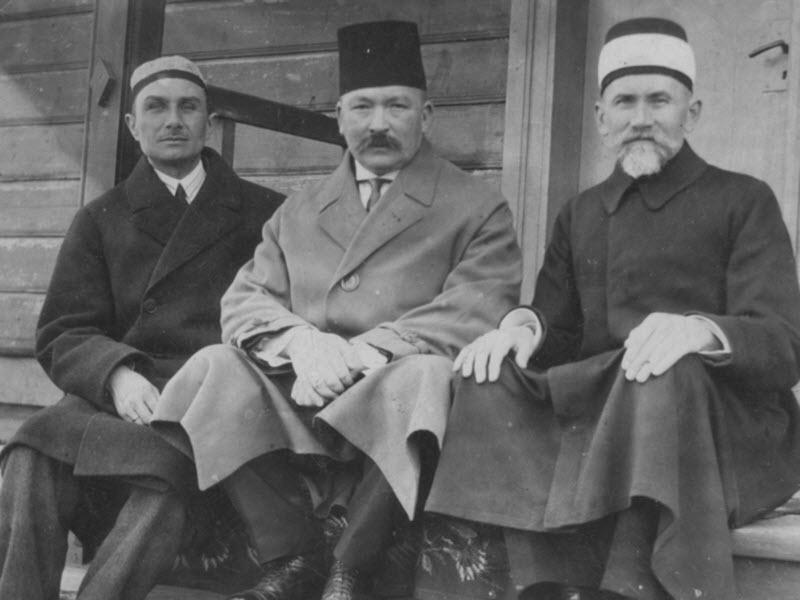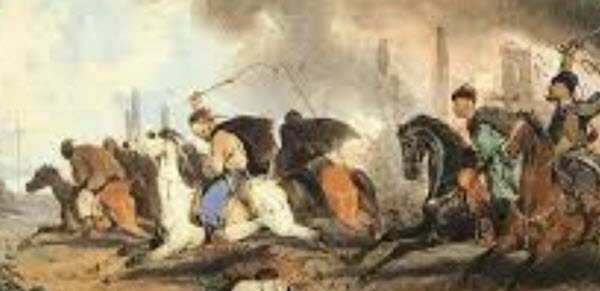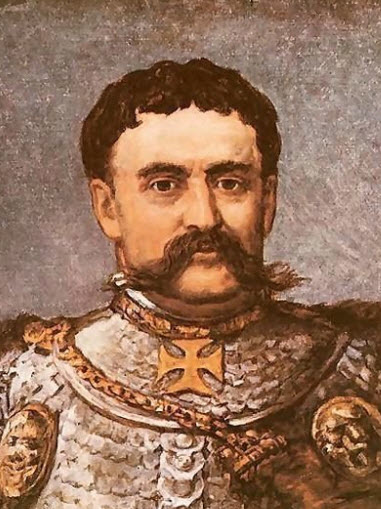
The word Lipka is derived from the old Crimean Tatar name for Lithuania, so Lipka Tatars simply means Lithuanian Tatars. The first Tatar migrants that settled in the Grand Duchy of Lithuania were not muslim; they practised a shamanistic Asian religion and sought asylum among the non-Christian Lithuanians. In the late 14th century AD, a new wave of Tatars arrived after being granted asylum by the Grand Duke of Lithuania (Vytuatas the Great). These Tatars were muslim.
The 1300s
On this page:
In the 1397, a Tatar leader named Tokhtamysh and the remnants of his people were granted asylum in the Grand Duchy of Lithuania. They needed asylum, since they had been fighting a series of military campaigns against their former protector, the Tatar warlord Tamerlane, with disastrous results.
Not only did the Grand Duke of Lithuania grant them asylum; he also gave them noble status and gifted them estates. (Information about this can be found in the Chronicles of Jan Glugosz, written in the 1400s.) The Grand Duke also partnered up with the Italian city state of Genoa to make a joint military expedition against Tamerlane, but the campaign wasn’t very successful, despite being outfitted with handguns (!).
The 1400s

On 15 July 1410, the joined forces of the Kingdom of Poland and the Grand Duchy of Lithuania (circa 39,000 men) defeated the Teutonic Knights (circa 27,000 men) in the Battle of Grundwald.
The battle was one of the largest in medieval Europe, and European history had probably looked quite different if the Teutonic Knights had won instead. After their defeat in Grundwald, the Teutonic Knights (The Order of Brothers of the German House of Saint Mary in Jerusalem) never recovered their former influence.
After the battle, rumours began to spread throughout Europe claiming that the Polish-Lithuanian force had been able to defeat the Germans because of the aid from tens of thousands of heathen (i.e. not Christian) Tatars. Later historians see this number as greatly inflated, and have estimated that approximately one thousand Tatar horse archers participated in the battle, including a core formed by the entourage of Jala ad-Din, the son of Tokhtamysh.
Still, it is not difficult to understand why the Tatars were described as such an important and awe inspiring force throughout Europe, because they did have a major impact on the outcome of the event. At the very start of the battle, Jalal ad-Din led the Lipka Tatar light cavalry on a suicide mission against the Teutonic Knight’s artillery positions. This made the Germans send their own heavy cavalry to pursue the Lipka Tatars, and the heavy cavalry trampled through the German’s own infantry in the process, spreading chaos and destroying their line of battle. This was a major factor for their subsequent loss.
The 1500s
1550s
According an account written by a Polish muslim for Süleyman the Magnificent during a stay in Constantinople in 1557-1558, there were roughly a hundred different Lipka Tatar settlements with mosques in Poland at this point in history. This anonymous writer also informed the sultan that the largest of these communities were found in the cities Lida, Navahradak and Iwye.
1560s
In 1569, the Polish-Lithuanian Commonwealth was founded. Just as they had previously been an important force in the Lithuanian army, the Lipka Tatar light cavalry now became an essential aspect of the commonwealth’s armed forces. In every significant military campaign involving the commonwealth, there were Lipka Tatars present.
1590s
According to some estimates, roughly 200,000 Lipka Tatars lived in the Polish-Lithuanian Commonwealth in 1590 and about 400 mosques had been built by them in the region. However, the fervent Catholicism of King Sigismund III Vasa, who had become monarch of the Polish-Lithuanian Commonwealth in 1587, had brought a number of restrictions on them and on other non-Catholics in the Commonwealth. In 1591, this caused friction between King Sigismund and Sultan Murad III.
The 1600s
In 1672, the Lipka Tatars rebelled against the Commonwealth, after having their religious freedoms and ancient rights and privileges gradually eroded. The igniting flame that turned widespread discontent into a full-blown rebellion was several Lipka Tatar cavalry regiments not being paid on time.

In 1674, the Bar-based Lipka Tatars who held Podolia for Turkey found themselves besieged by the armies of the Commonwealth’s monarch Jan III Sobieski, who had ascended the throne on 19 May 1674 and was actually held in very high esteem by the Lipka Tatars. A deal was struck where the Lipkas agreed to return as subjects of the Commonwealth, if their ancient rights and privileges were restored by the new ruler. Thus, the Lipka cavalry sided with Jan III Sobieski in his fight against the Ottoman Empire. In this sense, the Lipkas – themselves Muslims – fought against the Islamic expansion into Europe.
Important milestones:
- 1676: The Treaty of Zurawno give Lipka Tatars the right to freely chose, on an individual basis, of they want to serve the Ottoman Empire or the Polish-Lithuanian Commonwealth.
- 1677: The Sejm confirms all the ancient Lipka Tatar rights and privileges. The Lipka Tatars can now rebuild their mosques and are freed from all taxation. They can settle Christian labour on their estates, and they are permitted to buy estates even where the previous owner was not a Tatar.
- 1679: King Jan III Sobieski settles the Lipka Tatars on Crown Estates in the provinces Brest, Kobryn and Hrodna.
- 1683: Lipka Tatars participate in the Vienna Campaign.On September 12, the Battle of Vienna turns the tide of Islamic expansion into Europe. The Lipka Tatars fighting for the Commonwealth wears a sprig of straw in their helmets to avoid being miss taken for the Tatars fighting for the Turks. (This starts the tradition of Lipka Tatars wearing straw hats when visiting Vienna.)On October 7, the 60 Lipka Tatars in the light cavarly company led by Samuel Mirza Krzeczowski saves the life of the king during the first day of the Battle of Parkany.
The 1700s
From the late 1700s and onward, the Lipka Tatars become increasingly Polonized. The upper crust of the Lipka Tatars began using Polish as their main language, although they did not convert to Christianity. Middle-ranking Lipka Tatars followed the example of the upper echelon, while lower ranks largely adopted Ruthenian as their main language. (Ruthenian is an East Slavic language, or Old East Slavic dialect, depending on which scholar you ask.)
In 1775, the Sejm reaffirmed the noble status of the Lipka Tatars.
After the Partions of Poland toward the end of the 18th century, the Lipkas participated in various national uprisings.
The 1800s
The Lipka Tatars served along the ethnic Poles in the Napoleonic army (Grande Armée).
The 1900s
In 1919, the Lipka Tatars joined the newly formed Polish Army formation Pulk Jazdy Tatarskiej. Later, they would become a part of the 13th Regiment of Wilno Uhlans.
In 1939, a Polish Tatar regiment was re-established in the Polish Army, and given their own unique uniforms and banners.
After the fall of Poland in 1939, the Polish Tatars in the 13th Cavalry Regiment, based inVilnius and led by Major Aleksander Jeljaszewicz, was one of the very last Polish Army units that kept on fighting the Germans. On the 9th or 10th of September, the Tatar squadron executed the last charge against German infantry. This was the last time a Tatar unit fought in the Polish army. It should be noted however, that some of the Tatars in the unit managed to survive, escape the Germans and the Soviets, and re-join the Polish military.